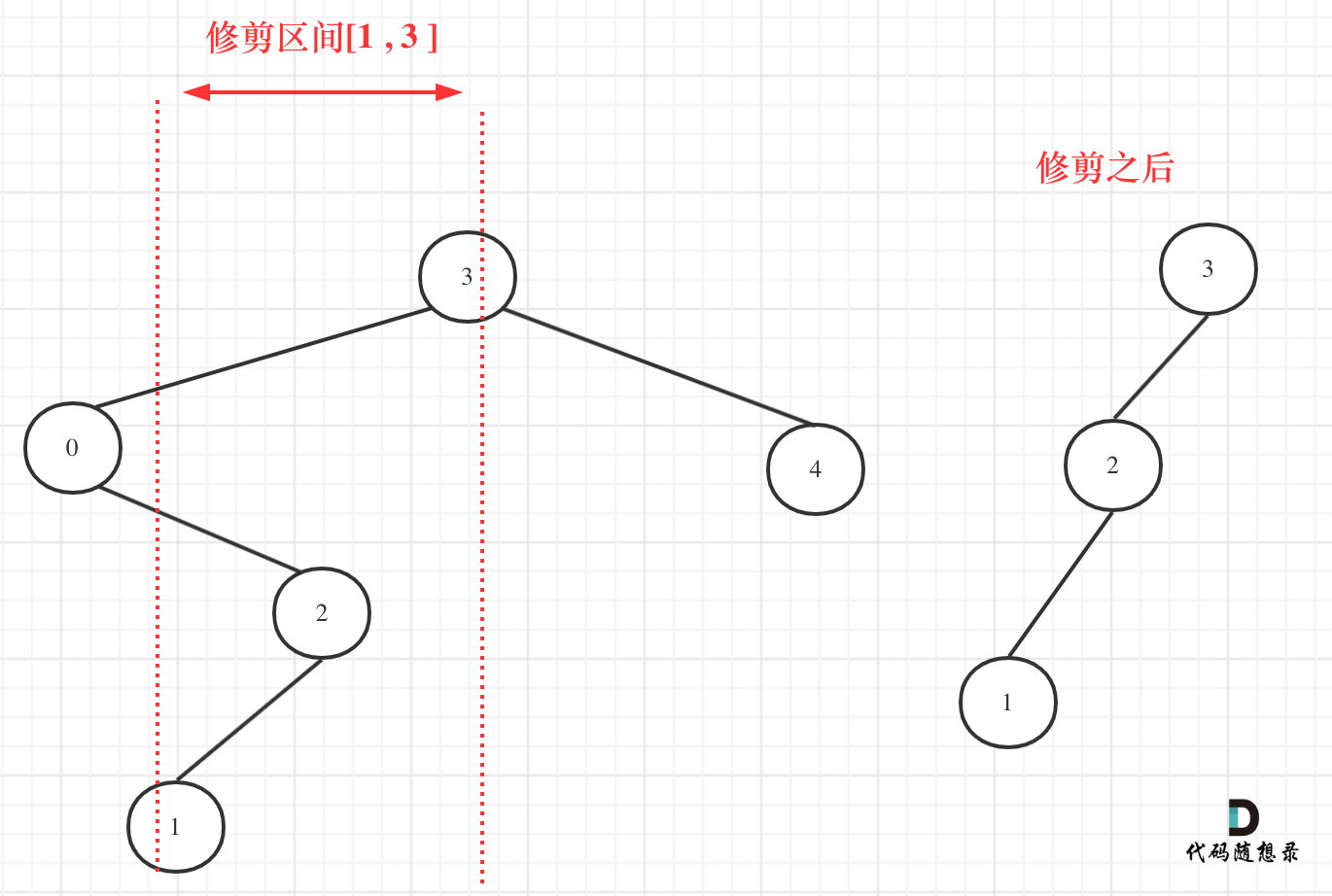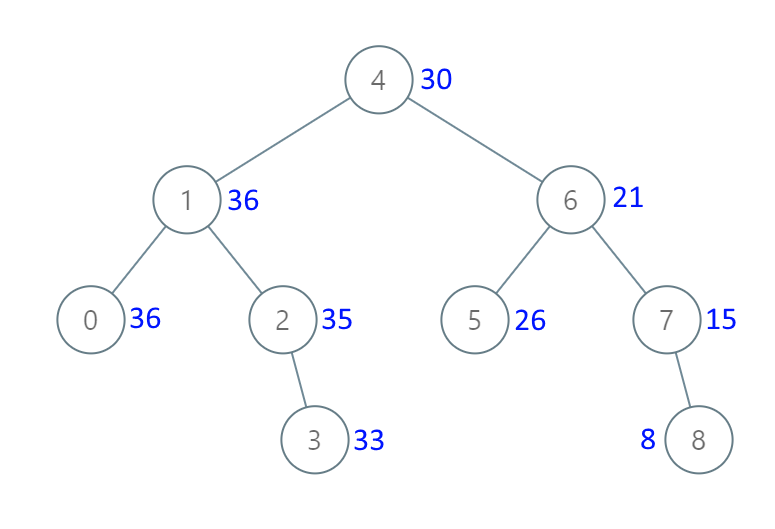目录
669. 修剪二叉搜索树
题目
给你二叉搜索树的根节点 root ,同时给定最小边界low 和最大边界 high。通过修剪二叉搜索树,使得所有节点的值在[low, high]中。修剪树 不应该 改变保留在树中的元素的相对结构 (即,如果没有被移除,原有的父代子代关系都应当保留)。 可以证明,存在 唯一的答案 。
所以结果应当返回修剪好的二叉搜索树的新的根节点。注意,根节点可能会根据给定的边界发生改变。
示例1:

输入:root = [1,0,2], low = 1, high = 2
输出:[1,null,2]
示例2:

输入:root = [3,0,4,null,2,null,null,1], low = 1, high = 3
输出:[3,2,null,1]
提示:
- 树中节点数在范围
[1, 104]内 0 <= Node.val <= 104- 树中每个节点的值都是 唯一 的
- 题目数据保证输入是一棵有效的二叉搜索树
0 <= low <= high <= 104
思路
注意点:并不是只要遇到一个不满足条件的节点就返回null,而是继续判断其孩子是否满足条件,如图:

题解
独立题解(很多判断条件和步骤可以省去):
class Solution {
public TreeNode trimBST(TreeNode root, int low, int high) {
if (root == null)
return null;
if (root.val < low) {
if (root.right == null)
return null;
if (root.right != null) {
root = trimBST(root.right,low,high);
return root;
}
}else if (root.val > high) {
if (root.left == null)
return null;
if (root.left != null) {
root = trimBST(root.left,low,high);
return root;
}
}
if (root!=null&&root.val >= low && root.val <= high) {
root.left = trimBST(root.left, low, high);
root.right = trimBST(root.right, low, high);
}
return root;
}
}
优化后:
class Solution {
public TreeNode trimBST(TreeNode root, int low, int high) {
if (root == null)
return null;
if (root.val < low) {
root = trimBST(root.right, low, high);
return root;
} else if (root.val > high) {
root = trimBST(root.left, low, high);
return root;
}
root.left = trimBST(root.left, low, high);
root.right = trimBST(root.right, low, high);
return root;
}
}
108.将有序数组转换为二叉搜索树
题目
108. 将有序数组转换为二叉搜索树 - 力扣(LeetCode)
给你一个整数数组 nums ,其中元素已经按 升序 排列,请你将其转换为一棵 平衡 二叉搜索树。
示例1:

输入:nums = [-10,-3,0,5,9]
输出:[0,-3,9,-10,null,5]
解释:[0,-10,5,null,-3,null,9] 也将被视为正确答案:

示例2:

输入:nums = [1,3]
输出:[3,1]
解释:[1,null,3] 和 [3,1] 都是高度平衡二叉搜索树。
提示:
1 <= nums.length <= 104-104 <= nums[i] <= 104nums按 严格递增 顺序排列
思路
视频讲解:LeetCode:108.将有序数组转换为二叉搜索树
注意题目要求为平衡二叉树,递归过程中先创建根节点,再创建左子树和右子树,最后返回根节点。
题解
独立题解:
class Solution {
public TreeNode sortedArrayToBST(int[] nums) {
return sortedArrayToBST(nums, 0, nums.length - 1);
}
TreeNode sortedArrayToBST(int[] nums, int start, int end) {
if (start > end)
return null;
int index = (end + start) / 2;
TreeNode root = new TreeNode(nums[index]);
root.left = sortedArrayToBST(nums, start, index - 1);
root.right = sortedArrayToBST(nums, index + 1, end);
return root;
}
}
538.把二叉搜索树转换为累加树
题目
538. 把二叉搜索树转换为累加树 - 力扣(LeetCode)
给出二叉 搜索 树的根节点,该树的节点值各不相同,请你将其转换为累加树(Greater Sum Tree),使每个节点 node 的新值等于原树中大于或等于 node.val 的值之和。
提醒一下,二叉搜索树满足下列约束条件:
- 节点的左子树仅包含键 小于 节点键的节点。
- 节点的右子树仅包含键 大于 节点键的节点。
- 左右子树也必须是二叉搜索树。
示例1:

输入:[4,1,6,0,2,5,7,null,null,null,3,null,null,null,8]
输出:[30,36,21,36,35,26,15,null,null,null,33,null,null,null,8]
示例2:
输入:root = [0,null,1]
输出:[1,null,1]
示例3:
输入:root = [1,0,2]
输出:[3,3,2]
示例4:
输入:root = [3,2,4,1]
输出:[7,9,4,10]
提示:
- 树中的节点数介于
0和104之间。 - 每个节点的值介于
-104和104之间。 - 树中的所有值 互不相同 。
- 给定的树为二叉搜索树。
思路
视频讲解:LeetCode:538.把二叉搜索树转换为累加树
按照右中左顺序遍历。
题解
独立题解:
class Solution {
int sum = 0;
public TreeNode convertBST(TreeNode root) {
if(root==null)
return null;
convertBST(root.right);
sum+=root.val;
root.val = sum;
convertBST(root.left);
return root;
}
}






















 421
421

 被折叠的 条评论
为什么被折叠?
被折叠的 条评论
为什么被折叠?








